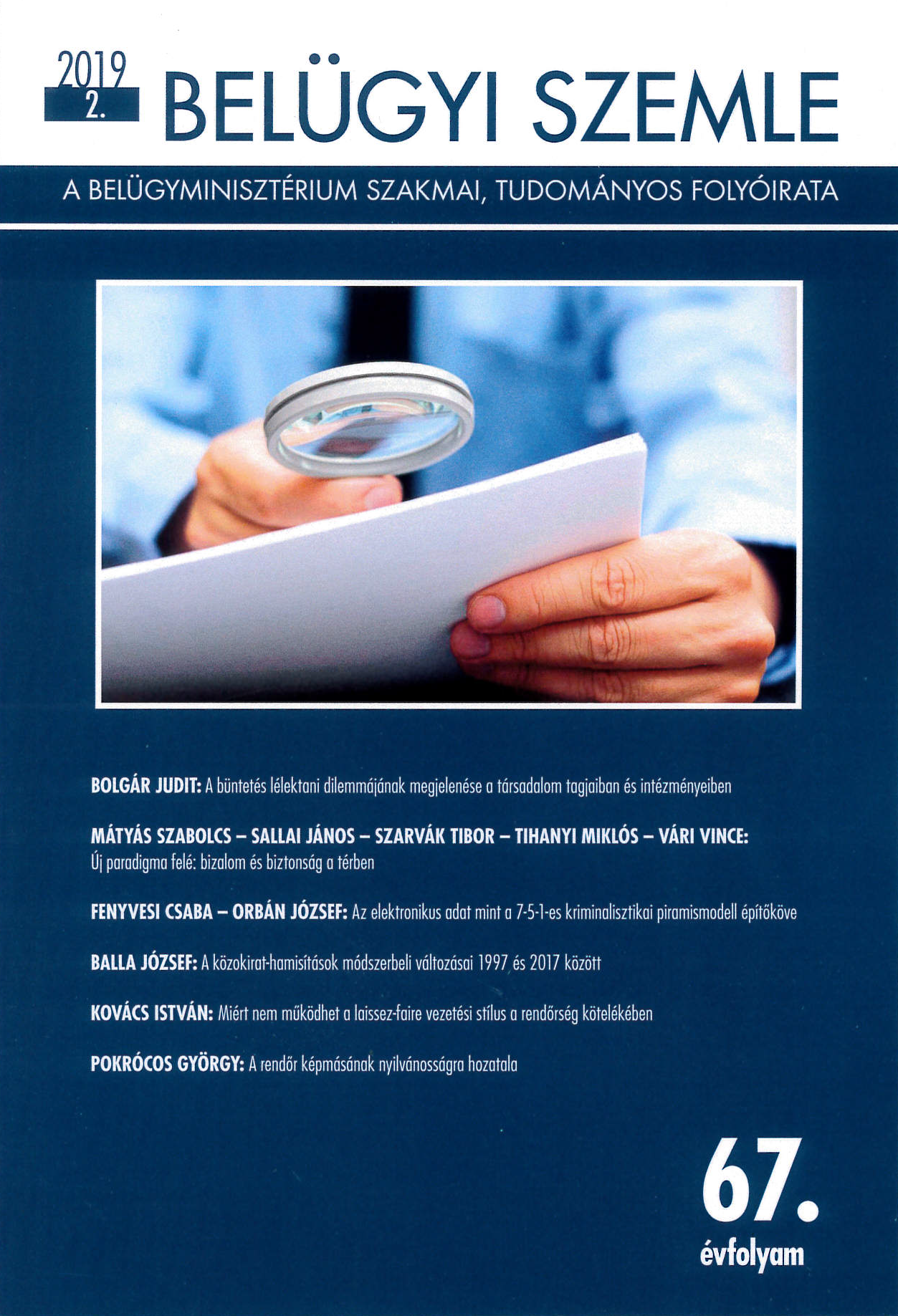Keywords
forensics
pyramid model
digital data
pyramid model
digital data
How to Cite
Electronic data as a cornerstone of the 7-5-1 forensic pyramid model. (2019). Academic Journal of Internal Affairs, 67(2), 45-55. https://doi.org/10.38146/BSZ.2019.2.3
Abstract
The authors provide an overview of the role of digital data in the “7-5-1” forensic identification pyramid model.
Downloads
Download data is not yet available.
Similar Articles
- Csaba Szabó, Place, role and possible organisation development directions of the Chamber of Bodyguards, Property Protection and Private Detectives from the perspective of the task system of the law enforcement administration model , Academic Journal of Internal Affairs: Vol. 66 No. 12 (2018)
- Richárd Tamás Pék, Csaba Fekete, Erika Gál, Katalin Erdélyi, Tibor Bánáti, Bernadett Bacsó, International Law Enforcement Observer VI. , Academic Journal of Internal Affairs: Vol. 70 No. 7 (2022)
- Lajos Hertelendi, Integrity with the “EYE” (SZEM) of law enforcement - or the law enforcement-specific features of solid morality in the service of corruption prevention , Academic Journal of Internal Affairs: Vol. 69 No. 11 (2021)
- Vince Vári, Police Performance Measurement in International Literature, with special focus on the Indicators of Legitimacy and Trust , Academic Journal of Internal Affairs: Vol. 67 No. 6 (2019)
- Csaba Fenyvesi, The role of line-up and digital data in a specific indidency case , Academic Journal of Internal Affairs: Vol. 64 No. 9 (2016)
- Kitti Mezei, The challenges and legislative novelties related to electronic evidence , Academic Journal of Internal Affairs: Vol. 67 No. 10 (2019)
- Kinga Sorbán, Law enforcement sciences and informatics , Academic Journal of Internal Affairs: Vol. 67 No. 11 (2019)
- Péter Polt, Digital development and criminal law - then and now , Academic Journal of Internal Affairs: Vol. 70 No. 11 (2022)
- Dávid Petrétei, Theoretical Issues of Forensic Identification , Academic Journal of Internal Affairs: Vol. 68 No. 2 (2020)
- Csaba Erdélyi , Gergely Hlavacska , Róbert Lajos Bogotyán , Tamás Drusza , Katalin Erdélyi , International Law Enforcement Observer X. , Academic Journal of Internal Affairs: Vol. 71 No. 6 (2023)
You may also start an advanced similarity search for this article.
Most read articles by the same author(s)
- Csaba Fenyvesi, The second version of the criminalist pyramid-model , Academic Journal of Internal Affairs: Vol. 62 No. 9 (2014)
- Csaba Fenyvesi, Justizmord and investigative errors , Academic Journal of Internal Affairs: Vol. 62 No. 3 (2014)
- Csaba Fenyvesi, Crime Prevention Function of Criminalistics , Academic Journal of Internal Affairs: Vol. 69 No. 10 (2021)
- Csaba Fenyvesi, Jack the Ripper and modern forensic methods , Academic Journal of Internal Affairs: Vol. 65 No. 7-8 (2017)
- Csaba Fenyvesi, Presentation for recognition and faith , Academic Journal of Internal Affairs: Vol. 66 No. 4 (2018)
- Csaba Fenyvesi, Global trends in forensic science in the 21st century , Academic Journal of Internal Affairs: Vol. 61 No. 10 (2013)
- Csaba Fenyvesi, Every police organization is only as good as its data , Academic Journal of Internal Affairs: Vol. 70 No. 11 (2022)
- Csaba Fenyvesi, Concepts and academic approaches in criminal investigation in continental and common law , Academic Journal of Internal Affairs: Vol. 63 No. 2 (2015)
- Csaba Fenyvesi, The role of line-up and digital data in a specific indidency case , Academic Journal of Internal Affairs: Vol. 64 No. 9 (2016)
- József Orbán, Introduction to the application of likelihood in forensic science , Academic Journal of Internal Affairs: Vol. 65 No. 2 (2017)

